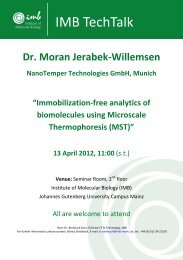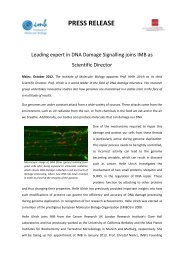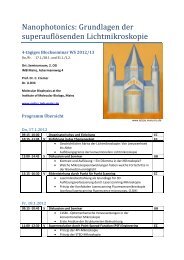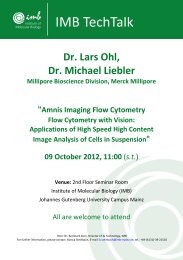Low-resolution PDF - IMB
Low-resolution PDF - IMB
Low-resolution PDF - IMB
You also want an ePaper? Increase the reach of your titles
YUMPU automatically turns print PDFs into web optimized ePapers that Google loves.
Super-<strong>resolution</strong> Light Microscopy of Functional Nuclear Architecture<br />
4<br />
“The limits of conventional<br />
microscopy have been<br />
overcome by a variety of<br />
super-<strong>resolution</strong> methods.”<br />
Christoph Cremer<br />
Education<br />
1970 Diploma in Physics, LMU, Munich<br />
1976 PhD in Biophysics and Genetics, University of Freiburg<br />
1983 Habilitation, University of Freiburg<br />
Positions held<br />
1970 - 1983 Staff Scientist, Institute of Human Genetics,<br />
University of Freiburg<br />
1983 - 1999 Managing/Deputy Director,<br />
Institute of Applied Physics I, University of Heidelberg<br />
1983 - 2011 Professor of Applied Optics & Information Processing,<br />
University of Heidelberg<br />
2005 - 2007 Deputy Director, Kirchhoff-Institute of Physics,<br />
University of Heidelberg<br />
Since 2005<br />
Since 2011<br />
Group Members<br />
Director Biophysics of Genome Structure,<br />
Institute for Pharmacy and Molecular Biotechnology,<br />
University of Heidelberg<br />
Group Leader, Institute of Molecular Biology (<strong>IMB</strong>),<br />
Mainz<br />
Udo Birk / Postdoc; since 02/2012<br />
Research Overview<br />
Until recently, the limits of conventional light microscopy (optical<br />
<strong>resolution</strong> about 200 nm in the object plane, 600 nm along the optical<br />
axis) have been a fundamental obstacle to the study of chromatin<br />
nanostructure and its importance to molecular epigenetics.<br />
This bottleneck has been overcome by a variety of super-<strong>resolution</strong><br />
(“nanoscopy”) methods. In 2012, we established various nanoscopy<br />
systems at <strong>IMB</strong>. Presently, these comprise a commercial laser scanning<br />
4Pi microscope (Leica) and two devices (our own developments) for<br />
spectrally assigned localization microscopy (SALM). We have integrated<br />
the SALM technique of spectral precision distance microscopy<br />
(SPDM) into laterally structured interference illumination microscopy<br />
(SIIM). The combination of ‘blinking’ with other spectral signatures<br />
based on differences in the absorption/emission spectrum and the use<br />
of standard fluorophors and preparation conditions, makes the new<br />
SPDM techniques developed a significant improvement over the original<br />
PALM/STORM approaches.<br />
Research Highlights<br />
1) Spatial distribution of various histone types<br />
Nuclear structure applications studied in 2012 in the Cremer-group<br />
include the spatial distribution of various histone types in normal/<br />
cancer cells before and after ionizing radiation exposure (collaborations:<br />
Prof. G. Dollinger, Munich, Prof. M. Hausmann and Prof. P. Huber,<br />
Heidelberg). Figure 1 shows an example for the spatial distribution of<br />
H2B – GFP and H4K20 obtained with the “Vertico-SPDM” at <strong>IMB</strong>. While<br />
in the conventional epifluorescence image, single molecule <strong>resolution</strong><br />
was not possible, the two-colour SPDM image shows thousands of<br />
individually identified H2B and H4K20 molecules resolved with a mean<br />
localization precision of 18 nm.<br />
For the first time, a single molecule <strong>resolution</strong> of individual γH2AX<br />
cluster tracks induced by individual accelerated heavy ions was<br />
obtained in nuclei of a glioblastoma cell line by three-colour SPDM-SIIM<br />
imaging.










